

Tomari shutdown leaves Japan without nuclear power. 5 mayo 2012Last updated at 09:06 GMT.
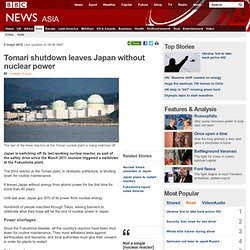
Japan's Nikkei at lowest year-end level since 1982. 30 December 2011Last updated at 07:21 Most of Japan's losses this year occurred on two days in March Japan's main share index has closed at its lowest end-of-year level since 1982. The Nikkei 225 index finished Friday up 0.7% to 8,455.35. Stocks have been hit by a weak global economy, as well as a devastating earthquake and tsunami on 16 March that left 20,000 people dead or missing and sparked a nuclear crisis. Japan’s Economic Gloom Runs Deeper This Time. Japan clarifies nuclear 'stress testing' 11 July 2011Last updated at 10:40 The Fukushima crisis has turned public opinion largely against nuclear power The Japanese government has tried to clarify its conditions for restarting dozens of nuclear reactors, idle since the 11 March tsunami and quake.
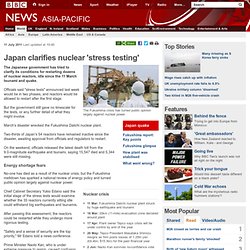
Officials said "stress tests" announced last week would be in two phases, and reactors would be allowed to restart after the first stage. But the government still gave no timescale for the tests, or any further detail of what they might involve. March's disaster wrecked the Fukushima Daiichi nuclear plant. Two-thirds of Japan's 54 reactors have remained inactive since the disaster, awaiting approval from officials and regulators to restart. On the weekend, officials released the latest death toll from the 9.0-magnitude earthquake and tsunami, saying 15,547 died and 5,344 were still missing. Japan Reconstruction Minister Ryu Matsumoto quits. 5 July 2011Last updated at 09:30 BBC's Roland Buerk: "Ryu Matsumoto's remarks were seen as high handed and offensive" Japan's Minister for Reconstruction Ryu Matsumoto has announced his resignation after just a week in the job.
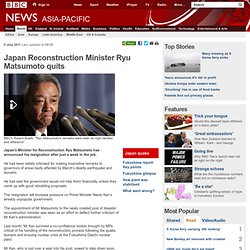
He had been widely criticised for making insensitive remarks to governors of areas badly affected by March's deadly earthquake and tsunami. He had said the government would not help them financially unless they came up with good rebuilding proposals. The resignation will increase pressure on Prime Minister Naoto Kan's already unpopular government. The appointment of Mr Matsumoto to the newly created post of disaster reconstruction minister was seen as an effort to deflect further criticism of Mr Kan's administration.
June 24, 2011. 24 June 2011Last updated at 06:29 Aerial images show the extent of damage to the No 1 reactor building at Fukushima Daiichi plant Chubu Electric, Japan's third biggest utility, will receive an emergency loan to purchase alternative sources of power, as the country continues to face a shortage.

The company will get a 100bn yen loan ($1.24bn; £775m) , it confirmed. Chubu was forced to shut down its Hamaoka power station amid fears of nuclear accidents. An earthquake and tsunami on 11 March caused a nuclear crisis at Fukushima, run by Tokyo Electric Power (Tepco). ‘Safety Myth’ Left Japan Ripe for Nuclear Crisis. June 7, 2011. 7 June 2011Last updated at 14:43. June 2, 2011. 2 June 2011Last updated at 07:38 Naoto Kan faced down a rebellion by some of his own party members Japanese Prime Minister Naoto Kan has survived a no-confidence motion brought by MPs critical of his handling of the earthquake and tsunami disaster. Before the motion was debated, Mr Kan told his party he would step down when the crises were under control. He was trying to head off a rebellion by senior members of his party which could have forced him from power. March's disaster killed thousands of people and crippled the Fukushima Daiichi nuclear plant. The BBC's Roland Buerk in Tokyo says Mr Kan has secured himself a few more months in power, but he has been left a weakened figure by the rebellion in his party.
May 28, 2011. 29 May 2011Last updated at 00:24 The problems with the Fukushima nuclear plant have raised questions over Tepco's future Japan's crippled Fukushima nuclear plant is not fully prepared for heavy rain and winds of a typhoon heading towards the country, officials admit.

Tokyo Electric Power (Tepco), which runs the plant, said some reactor buildings were uncovered, prompting fears the storm may carry radioactive material into the air and sea. Typhoon Songda is expected to hit mainland Japan as early as Monday. Fukushima was heavily damaged by the deadly 11 March quake and tsunami. 'Inappropriate measures' "We have made utmost efforts, but we have not completed covering the damaged reactor buildings," a Tepco official said on Saturday.
May 27, 2011. In recent days, worried parents have spoken out over what they say is a blatant government failure to protect their children from dangerous levels of radiation at local schools.

The issue has quickly become a focal point for anger over Japan’s handling of the accident at Tokyo Electric Power’s Fukushima Daiichi nuclear power plant, which was ravaged by the March 11 earthquake and tsunami. There had been particular anger over new government guidelines that allowed schoolchildren to be exposed to radiation doses that were more than 20 times the previously permissible levels. That dose is equal to the international standard for adult nuclear power plant workers.
May 24, 2011. 24 May 2011Last updated at 04:59 The problems with the Fukushima nuclear plant have raised questions over Tepco's future Tokyo Electric Power (Tepco) has confirmed the meltdown of extra fuel rods in reactors at its damaged Fukushima nuclear power plant.
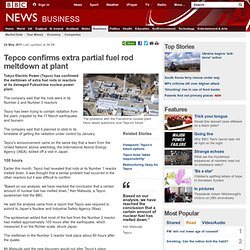
The company said that the rods were in its Number 2 and Number 3 reactors. May 22, 2011. 22 May 2011Last updated at 12:59 Japanese Prime Minister Naoto Kan (centre) is hosting the talks in Tokyo The leaders of Japan, China and South Korea have agreed to set up an early warning system to alert each other of emergencies at nuclear facilities.
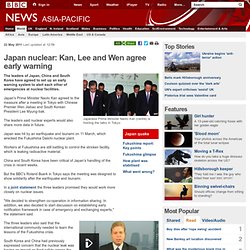
Japan's Prime Minister Naoto Kan agreed to the measure after a meeting in Tokyo with Chinese Premier Wen Jiabao and South Korean President Lee Myung-bak. The leaders said nuclear experts would also share more data in future. May 21, 2011. Pool photo by Junji Kurokawa President Lee Myung-bak of South Korea met a resident of a shelter on Saturday in Miyagi Prefecture in northeast Japan. Premier Wen Jiabao of China and President Lee Myung-bak of South Korea arrived in Japan on Saturday for a two-day meeting that was expected to focus on resolving differences over Japan’s handling of the nuclear crisis. China and South Korea have criticized Japan for spilling radiation into the air and sea, and have banned imports of farm products from areas near the plant, citing what they call inadequate checks for radiation.
May 20, 2011. 20 May 2011Last updated at 09:48 Mr Shimizu's resignation had been widely expected The president of Tepco, which operates Japan's crippled Fukushima nuclear power plant, has resigned as the firm reported a loss of 1.25tn yen ($15.3bn; £9.4bn) for the past financial year.

Masataka Shimizu will be replaced by managing director Toshio Nishizawa. Tepco's loss is a record for a non-financial firm in Japan. May 17, 2011. 17 May 2011Last updated at 13:43 Residents from around the Fukushima plant have been allowed to make brief visits to their houses Japan still believes it can end its nuclear crisis within months, while accepting damage from March's quake and tsunami was worse than first thought.

The government and the operator of the Fukushima Daiichi power plant recently revealed the No 1 reactor suffered a near complete meltdown within hours of the disaster. But they still believe a "cold shutdown" is possible by January. The crisis forced 80,000 people who lived within 20km of the plant to flee. This week evacuations began from towns further away from the stricken plant in northern Japan, with the government saying a build-up of radiation could pose a danger to health, says the BBC's Roland Buerk in Tokyo.
Melted floor Officials from the Tokyo Electric Power Company (Tepco) say fuel rods at the plant began to melt down as early as six hours after the 11 March tsunami knocked out vital cooling systems. Fukushima meltdown: two months later, Japan's government still drags its feet. In the latest in its ongoing series of late-night announcements, TEPCO this week finally admitted that the core of Fukushima’s reactor 1 started melting a mere five hours after the March 11 earthquake, and reached full meltdown within 16 hours. The power company also confirmed that it was the earthquake, and not just the tsunami that initiated the series of failures leading to the reactor core meltdown. Molten fuel then pooled at the bottom of the reactor vessel and with the container consequently breached, radioactive material was able to leak out with the cooling water and find its way into the ground and ocean where it is now accumulating in the soil, sediment and food chain.
The new information also highlight the government’s reluctance to speak plainly and frankly about the risks to public health and the environment, and underscores its remarkable foot dragging in its response to these threats. For example: This is not to say the authorities are doing nothing. In Japan Reactor Failings, Danger Signs for the U.S. May 16, 2011. 16 May 2011Last updated at 11:03 Residents from Kawamata and Iitate are now in evacuation centres Residents have been moved further away from the crippled Fukushima nuclear plant in northern Japan as the no-go zone is extended and there is a new setback at the plant. Residents of the towns of Kawamata and Iitate were sent to evacuation centres.
May 13, 2011. Experts have warned of a potentially dangerous radiation leak if Japan proceeds with plans to flood a damaged reactor containment vessel at the Fukushima Daiichi nuclear plant. May 10, 2011. Japan’s Leader Cancels Plan for New Nuclear Plants. May 6, 2011. 9 May 2011Last updated at 11:48. Help stop the next Fukushima disaster. Despite the nuclear disaster at Fukushima witnessed by the world, there are plans to build a major nuclear power station in a highly earthquake-prone region on the west coast of India. After Disaster Hit Japan, Electric Cars Stepped Up. May 5, 2011. May 2, 2011. April 30, 2011. Status of the reactors. APRIL 18About 4,500 gallons of liquid glass are injected into the power cable trench that leaked radioactive water earlier in the month. APRIL 18, 1:42 PMA remote-control robot in the reactor building finds high levels of radiation.
APRIL 17Water samples taken from a surge tank near the reactor are found to have high levels of radioactive cesium and iodine. April 28, 2011. April 27, 2011. April 26, 2011. Nuclear power mapped. Japan Announces Emergency Budget for Rebuilding. The $48.5 billion budget is likely to be followed by more spending as takes on the gargantuan task of rebuilding the section of its Pacific coastline ravaged by the March 11 earthquake and tsunami. Parliament is expected to pass the budget next week. At least 14,133 people have been found dead, an additional 13,346 remain missing and more than 130,000 are living in evacuation centers. Government estimates put the total damage from the quake and tsunami at $300 billion.
Do we know the Chernobyl death toll? - The Drum Opinion. April 22, 2011. Japan government announces disaster relief budget. April 21, 2011. April 17, 2011. Nine-Month Plan Is Set for Crippled Japanese Plant. Katsunobu Sakurai. April 18, 2011. April 16, 2011. April 15, 2011. April 14, 2011. April 12, 2011. Japan Tries to Explain Delays in Reporting Radiation. How does Fukushima differ from Chernobyl? April 11, 2011. Japan Urges More People Around Nuclear Plant to Evacuate. Japan extends evacuation zone. April 10, 2011. April 9, 2011. Rice growing a radioactive topic in Japan amid Fukushima Dai-Ichi nuclear crisis. Radioactive cesium over legal limit found in fish off Japan's Fukushima. Untrained, itinerant, temporary laborers handle the bulk of the dangerous work. April 8, 2011. Lack of Data Heightens Japan’s Nuclear Crisis. April 6, 2011. How Many Cancers Did Chernobyl Really Cause?
N.R.C. Suspects Leak in Core of Japan Nuclear Reactor. Nitrogen pumped into nuclear reactor. April 5, 2011. U.S. Sees Array of New Threats at Japan’s Nuclear Plant. How Fukushima's Radioactive Cloud Influenced My Country. April 4, 2011. The incalculable cost of nuclear power. April 2, 2011. Radioactive water from Japan nuclear plant leaks in sea. April 1, 2011. Japan plant - who is in charge? Frustration, tragedy, heroism and spreading contamination. Japan nuclear evacuation 'will be long-term' March 31, 2011. IAEA confirms need for more evacuations. March 28, 2011. Germany: Greens celebrate Merkel election defeat. March 27, 2011. Call to widen evacuation area around Fukushima. March 26, 2011. Japanese Rules for Nuclear Plants Relied on Old Science. March 20, 2011. March 19, 2011. March 18, 2011. March 17, 2011. March 16, 2011. March 15, 2011. March 13, 2011. March 12, 2011. March 11, 2011. Photos: The Calamity of Japan's 9.0-Magnitude Quake.
March 9, 2011.